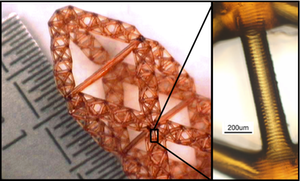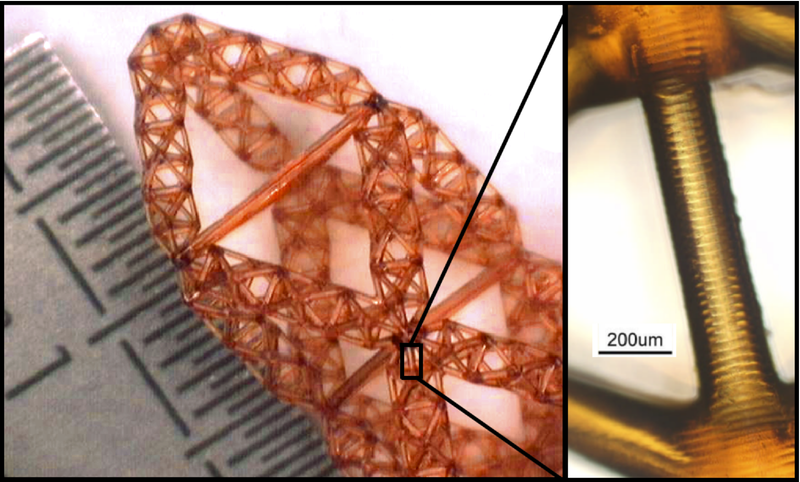Fractal Structures Do More with Less
The “spongy” bone found near joints is strong but light, thanks to a network of struts and fibers whose pattern looks similar regardless of the magnification of your microscope. Researchers have imitated this hierarchical (or fractal) design in artificial materials, and now calculations in Physical Review Letters describe the weight reduction that such fabrication offers and how it can be optimized. The work gives an analytical basis to fractal design and shows that large structures like solar sails can be made significantly lighter using hierarchical elements.
Engineers trying to reduce the weight of a piece of equipment they are designing will often shave away material that is found to be superfluous for supporting a particular load. But another strategy is to reduce the mass from the start by using a hierarchical approach, where the same sparse patterns appear at different length scales, says Yong Mao of the University of Nottingham, UK. The practice is common in architecture—the Eiffel Tower is effectively a big metal rod made up of smaller metal rods—but only recently have the tools become available for controlling fabrication at the smallest scales [1].
Mao and his colleagues have worked previously on specific applications of hierarchical structures built with solid rods [2]. They have now developed a theoretical framework that assesses the advantages of hierarchical structures in general. They began with a hollow tube as their “generation- ” element and varied the diameter and thickness to obtain the strongest tube with the least amount of material. To assess the strength, the team considered different ways that a tube could fail when squeezed along its length, such as bowing out like an archery bow (Euler buckling) or crumpling up along its axis (Koiter buckling). The researchers calculated the relationship between the volume of material making up the tube and the maximum load that the tube could support. As an initial check, their calculations showed that a chair leg made of a hollow steel tube can be nearly times lighter than an equally strong solid rod.
In the first step of their analysis of hierarchical structures, they looked at a larger-scale beam made of a triangular framework of generation- tubes, which they call “generation- .” Taking the example of a crane, with its typical load and height requirements, the team found that a generation- structure made of steel would be times lighter than a solid steel crane, which explains why large cranes have open-lattice frames. “People are effectively imitating the fractal design in an ad hoc fashion,” Mao says, and his team’s analysis shows the logic behind common engineering choices as well as the potential benefits of a fully hierarchical approach. A generation- structure, for example, would be one made up of generation- struts assembled into a larger triangular frame. The calculations showed that the more hierarchical levels one adds (up to about generation- ), the less material is needed to support a given load.
To demonstrate the weight savings of higher generation structures, the team considered solar sails, which would utilize -meter-long beams to support the load from the Sun’s radiation pressure. Here, a steel structure with three generations would be times lighter than a solid beam (which is not a proposed structure but a standard reference for comparisons). In other regimes, however, the weight savings of fractal designs may be smaller. For example, spongy, or “trabecular,” bone only provides about a percent reduction in weight, but apparently that was enough for evolution to prefer it, Mao says.
Still, to be useful for engineers, the weight savings needs to outweigh the cost and complication of fabricating on multiple levels. Moreover, hierarchical structures are more sensitive to mechanical imperfections. A small error in the fabrication process can be catastrophic when there’s not “extra” material around to shoulder the added stress. The group is currently studying ways to incorporate error tolerance into their models.
“The work is certainly important and timely considering the current interest in development of lightweight multifunctional materials,” says Ashkan Vaziri of Northeastern University in Boston. He thinks the results could have implications for aerospace designs and for “understanding the mechanical behavior of biological systems with cellular-based structures, where hierarchy is one of the key features.”
–Michael Schirber
Michael Schirber is a Corresponding Editor for Physics Magazine based in Lyon, France.
References
- T. A. Schaedler, A. J. Jacobsen, A. Torrents, A. E. Sorensen, J. Lian, J. R. Greer, L. Valdevit, and W. B. Carter, “Ultralight Metallic Microlattices,” Science 334, 962 (2011)
- D. Rayneau-Kirkhope, Y. Mao, R. Farr, and J. Segal, “Hierarchical Space Frames for High Mechanical Efficiency: Fabrication and Mechanical Testing,” Mech. Res. Commun. 46, 41 (2012)
More Information
Fractal Analysis of Trabecular Bone from the Department of Radiology at the University of Washington





